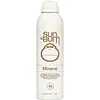What's inside
What's inside
 Key Ingredients
Key Ingredients

 Benefits
Benefits

 Concerns
Concerns

 Ingredients Side-by-side
Ingredients Side-by-side

Butyl Methoxydibenzoylmethane 3%
UV AbsorberHomosalate 10%
Skin ConditioningEthylhexyl Salicylate 5%
UV AbsorberOctocrylene 10%
UV AbsorberAlcohol Denat.
AntimicrobialPolyester-8
Skin ConditioningAcrylates/Octylacrylamide Copolymer
Dimethicone
EmollientPPG-5-Ceteth-20
EmulsifyingAcrylates/Dimethicone Copolymer
Skin ConditioningCyclopentasiloxane
EmollientParfum
MaskingTocopheryl Acetate
AntioxidantTrisiloxane
Skin ConditioningAscorbyl Palmitate
AntioxidantButyl Methoxydibenzoylmethane 3%, Homosalate 10%, Ethylhexyl Salicylate 5%, Octocrylene 10%, Alcohol Denat., Polyester-8, Acrylates/Octylacrylamide Copolymer, Dimethicone, PPG-5-Ceteth-20, Acrylates/Dimethicone Copolymer, Cyclopentasiloxane, Parfum, Tocopheryl Acetate, Trisiloxane, Ascorbyl Palmitate
Zinc Oxide 14%
Cosmetic ColorantWater
Skin ConditioningHelianthus Annuus Flower
Skin ConditioningButyloctyl Salicylate
Skin ConditioningCarthamus Tinctorius Seed Oil
MaskingCaprylic/Capric Triglyceride
MaskingBentonite
AbsorbentMethyl Dihydroabietate
Parfum
MaskingCetearyl Alcohol
EmollientAloe Barbadensis Leaf Juice
Skin ConditioningGlycerin
HumectantMicrocrystalline Cellulose
AbsorbentCellulose Gum
Emulsion StabilisingCoco-Glucoside
CleansingCaprylhydroxamic Acid
Caprylyl Glycol
EmollientJojoba Esters
EmollientBisabolol
MaskingTocopherol
AntioxidantPolyhydroxystearic Acid
EmulsifyingZinc Oxide 14%, Water, Helianthus Annuus Flower, Butyloctyl Salicylate, Carthamus Tinctorius Seed Oil, Caprylic/Capric Triglyceride, Bentonite, Methyl Dihydroabietate, Parfum, Cetearyl Alcohol, Aloe Barbadensis Leaf Juice, Glycerin, Microcrystalline Cellulose, Cellulose Gum, Coco-Glucoside, Caprylhydroxamic Acid, Caprylyl Glycol, Jojoba Esters, Bisabolol, Tocopherol, Polyhydroxystearic Acid
Ingredients Explained
These ingredients are found in both products.
Ingredients higher up in an ingredient list are typically present in a larger amount.
Parfum is a catch-all term for an ingredient or more that is used to give a scent to products.
Also called "fragrance", this ingredient can be a blend of hundreds of chemicals or plant oils. This means every product with "fragrance" or "parfum" in the ingredients list is a different mixture.
For instance, Habanolide is a proprietary trade name for a specific aroma chemical. When used as a fragrance ingredient in cosmetics, most aroma chemicals fall under the broad labeling category of “FRAGRANCE” or “PARFUM” according to EU and US regulations.
The term 'parfum' or 'fragrance' is not regulated in many countries. In many cases, it is up to the brand to define this term.
For instance, many brands choose to label themselves as "fragrance-free" because they are not using synthetic fragrances. However, their products may still contain ingredients such as essential oils that are considered a fragrance by INCI standards.
One example is Calendula flower extract. Calendula is an essential oil that still imparts a scent or 'fragrance'.
Depending on the blend, the ingredients in the mixture can cause allergies and sensitivities on the skin. Some ingredients that are known EU allergens include linalool and citronellol.
Parfum can also be used to mask or cover an unpleasant scent.
The bottom line is: not all fragrances/parfum/ingredients are created equally. If you are worried about fragrances, we recommend taking a closer look at an ingredient. And of course, we always recommend speaking with a professional.
Learn more about Parfum